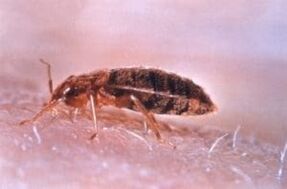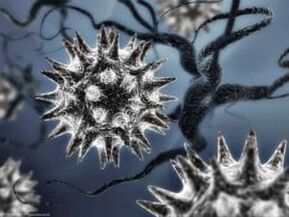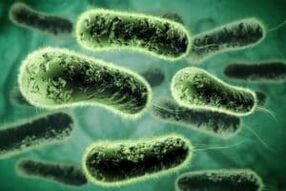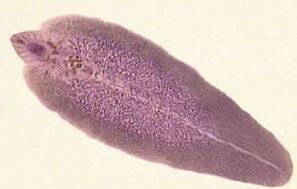Knowing the routes of entry of parasites into the body, you can take preventive measures in contact with possible sources of infection. What helminths are as intestinal parasites is known to many. However, the common man is less aware of the species that live in the circulatory system, subcutaneous lymph, muscles, brain, and internal organs.
All types of parasites in the human body are divided into representatives: protozoa, flat and round worms, arthropods and their larvae.Viruses, pathogenic bacteria and fungi can be classified as parasites, but are divided into a separate group. Infectious diseases are divided into: viral, fungal, bacterial and parasitic. The classification of human parasites includes - a unique species of fish (Vandellia) that can enter the human urethra (random host).
Parasitism and its types

Who are parasites? These are organisms that live at the expense of another individual, are not genetically related to them and enter into antagonistic relationships, that is, they disrupt life. The concept of parasitism should not be transferred to microorganisms that live in the body without causing it special harm. In nature there are plant and animal parasites, depending on the host type. During the functioning of this way of life, the parasite and host systems are constantly working. The task of the first: to live from the second without killing it for a long time.
Classification of parasites by type:
- Locations: external and internal parasites (exo- and endoparasites).
- Way of life: constantly parasitic (obligate) and free-living forms which, under certain conditions, begin to exist at the expense of another organism (facultative parasites).
- At the time of contact with the host: temporary and permanent parasites (stationary and periodic).
In the food chain, animal parasites are usually second or third order consumers because they feed on herbivores or carnivores. The way the parasite feeds itself deprives the host of nutrients and / or leads to the destruction of cells and tissues. Host antagonism often occurs because dangerous residents release toxic metabolic products. This leads to certain symptoms (allergies, disorders of the digestive system, signs of damage to various internal organs).
Viruses

Viruses are intracellular parasites of a protein-genetic structure. They multiply due to the materials in the cell. The virus is an obligatory parasite.
Depending on the type of genetic material, viruses containing RNA and DNA are isolated depending on the type of genetic material. Intracellular agents of the first group include:
- Enteroviruses. They multiply in the digestive tract and cause problems in various human organs.
- rhinoviruses. Pathogen from ARVI.
- Influenza, rabies and tick-borne encephalitis viruses.
- papilloma viruses.
The second group includes: adenoviruses (which cause acute respiratory infections), herpes and smallpox pathogens.
Viruses that get into the target cell subordinate their processes to themselves, integrate themselves into the genetic material or localize in the cytoplasm and then replicate (multiply). Then cell death occurs as a result of lysis, apoptosis, or distortion of the membrane structure. Some representatives (papillomavirus, Epstein-Barr virus) can cause cells to degenerate into malignant cells.
How viruses get inside:
- In the air.
- Through the gastrointestinal tract when drinking water and eating.
- Through the skin and the outer mucous membranes such as the conjunctiva of the eye.
- With the help of arthropod vectors (insects, ticks).
- Due to the use of non-sterile medical devices (syringes, pipettes).
Every virus is adapted to a specific cell and uses receptors to differentiate its target.
bacteria

Rickettsia, intracellular parasites, occupy a special position among bacteria. These are the most primitive representatives, similar to viruses. In humans, these microorganisms cause: typhoid, tick-borne rickettsiosis, Rocky Mountain spotted fever. People become infected with rickettsiae through cracks from ticks, fleas, and lice.
Other intracellular parasites of chlamydia cause one of the most common sexually transmitted diseases (chlamydia) and cause serious eye infections, pneumonia in infants, and enteritis.
Dangerous bacteria include:
- Salmonella are the causative agents of typhus.
- Tetanus stick.
- A pale spirochete that causes syphilis due to a difficult diagnosis of the disease, resulting in a delay in treatment.
- pneumococci, which can cause pneumonia and, less often, bacterial meningitis.
- tuberculosis bacillus, which may not manifest itself for a long time, and then turn into an open form.
- Escherichia coli for its ability to gain antibiotic resistance. Causes gastroenteritis, rarely meningitis and urinary tract infection.
External parasites such as Staphylococcus aureus are known to cause a wide variety of skin infections. The most dangerous consequences of its activity: pneumonia, meningitis, osteomyelitis, endocarditis, severe shock from exposure to bacterial toxins and sepsis (in everyday life it is called blood poisoning).
mushrooms

Pathogenic fungi - human parasites are better protected from the effects of drugs than bacteria. The most common fungal disease is candidiasis (thrush), which is localized on various mucous membranes with a weakened immune system. Fungi of the genus Candida live in the body of a healthy person and only cause noticeable damage when the protective function fails. Conditionally pathogenic bacteria and fungi are a boundary group of microorganisms between non-pathogenic and pathogenic categories. Therefore, they are usually not classified as parasites.
Pathogenic micellar fungi are human parasites that often cause diseases of the external integument:
- Keratomycosis. The multiplication of fungi takes place in the keratinized zone of the epidermis or on the hair cuticles (Trichosporia nodosum, versicolor versicolor).
- dermatophytosis. Pathogens affect not only the epidermis, but also the dermis, nails and hair (ringworm, scab).
- Deep mycoses. Damage to the skin and nearby tissues, as well as internal organs. These include histoplasmosis - a severe systemic fungal disease, and aspergillosis - damage to the mucous membranes and skin caused by Aspergillus.
The classic sources of bacterial and fungal infections are sick people, animals, soil, dirty water and food.
Protozoa
Besides bacteria and fungi, protozoa are another single-cell parasite. Which protozoan parasites of a person are isolated depending on the systematic position?
- Some types of amoeba are facultative parasites. The best known is the dysentery amoeba, which enters the human body in the form of a cyst (resting form). The pathogen enters the large intestine (lumen shape), then penetrates the mucous membrane and influences various internal organs with the bloodstream. Amoebas are aquatic organisms, so the main source of infection with them is dirty water. Acanthamoebic keratitis is a rare eye disease called acanthamoebic keratitis that has become more common due to the increased popularity of contact lenses.
- Flagellates (Leishmania, Giardia, Trichomonas). Trichomoniasis is the most common disease of the genitourinary system, dangerous for its complications (infertility, prostatitis, premature birth, etc. ).
- Apic complexes (sporozoa). With the exception of Colpodellidae, the group only includes obligate parasites (Toxoplasma, Plasmodium malaria, Cryptosporidium, Coccidia, sarcocysts). Sporozoic cysts enter the body after being bitten by insects, eating infected animals, or drinking water.
- ciliates. Balantidie is dangerous for humans and causes diarrhea and ulcers in the intestinal wall due to its activity in the large intestine. Ciliates are the largest pathogenic unicellular organisms.
The simplest human parasites cause protozoal infections (protozoses). Which parasites live in the human nervous system among the protozoa? For example the causative agents of toxoplasmosis and cerebral malaria. Among the amoebas, the facultative parasite Neglerius Fowler can infect the nervous system.
Multi-cell
The multicellular parasites include flatworms, roundworms, arachnids and insects. The former, as a rule, settles in a person (in different systems and internal organs), and certain species migrate or invade the subcutaneous layer (rishta, larvae of Gnathostoma spinigerum and hookworms, schistosomes). Worms is the colloquial name of all worms that cause helminth infestation (helminthiasis).
Common diseases caused by flatworms
Group of trematodes (digenetic flukes):
- Opisthorchiasis. Pathogen: types of liver fluke, e. g. B. Cat and Siberian coincidence. Infection results from the consumption of infected river fish that are poorly thermally processed.
- fascioliasis. Caused by liverworms and giant worms. Infection occurs through consumption of contaminated water or coastal grass.
- Schistosomiasis. The pathogens of schistosomes (especially leeches) live mainly in hot climates. They penetrate the skin through contact with water.
- paragonimiasis. The cause of the disease is a lung accident that occurs in hot climates. A thermally freshwater crab or crab infected with worms and poorly processed is dangerous.

The life cycle of the parasite from the trematode group is complex and includes several larval stages and gastropods as intermediate carriers. Flukes are animal parasites of vertebrates that act as temporary and permanent hosts. Individual larval stages can develop without fertilization. The devices from Flukes for fixing and feeding in the host are suction cups.
Tapeworms are obligatory parasites of the human small intestine. Your body is made up of segments (proglottids) that regularly break off and come out along with the fertilized eggs. The life cycle stages of tapeworms inevitably include the finna (bladder worm), which forms in a temporary owner. The permanent host swallows the Finn, which develops into a tapered (adult) shape. The structural features of tapeworms are the lack of a digestive system and the absorption of nutrients through the entire surface.
Most common:
- Beef tapeworm (unarmed tapeworm) causes teniarin disease. The infection occurs through the meat of cattle, the muscles of which are contained by the Finns, and which form in the body after the animals swallow eggs with feed.
- Pork tapeworm (armed tapeworm) causes cysticercosis (Finn stage) and teniasis (adult). In addition to the suction cups, the helminth is equipped with a hook edge. One person can act as both an intermediate and a permanent owner at the same time.
- The wide tapeworm causes diphyllobothriasis. Intermediate hosts are copepods and fish. A person can become infected from insufficiently salted caviar and poorly cooked or fried freshwater fish.
The parasites feed on blood and tissue (leeches) or digested food (tapeworms).
roundworms
What common types of parasites in humans are roundworms (nematodes)?

- Ascaris. Ascariasis includes stages of migration (larvae) and intestinal stages (adults). The larva penetrates the wall of the small intestine, migrates to the lungs, bypasses the liver and heart and goes through the molting stages one after the other. It gets into the oral cavity, is swallowed again, and grows up in the small intestine.
- pinworm. The enterobiasis pathogen feeds in the end and beginning zones of the small and large intestines and multiplies in the ileum. Women lay eggs in the anal folds and cause severe itching.
- Vlasoglav is the cause of trichocephalosis. These parasites in the human body invade the mucous membrane of the initial section of the large intestine and feed on tissue fluid and blood.
- Trichinella causes dangerous trichinosis. In severe cases, the nervous system is damaged. These are real killers, the larvae of which penetrate the wall of the small intestine and are carried around the body. Most often, they get into the striated muscles, can enter the eyes and cause pain and swelling in the face, lungs, causing a cough. So far, no cure for a full recovery has been invented.
- Toksokara. Differentiate between larvae (more common) and imaginary (intestinal) toxocariases. The invasion is characterized by the severity of allergic reactions. The larvae spread throughout the body, penetrate the tissue, encapsulate and form granulomas.
- Hookworms are more common in the tropics and subtropics. When hookworms become infected, the worms secrete proteolytic enzymes in the intestines, which destroy the walls and reduce blood clotting. Parasites in a person are caused by the penetration of larvae from polluted water through the skin.
- Escherichia coli and related species are tropical parasites. The disease they cause, strongyloidosis, can be asymptomatic for decades. With reduced immunity, those who carry the worm are at high risk of death (60-85%).
- Rishta is a subtropical helminth that causes dracunculiasis. The larvae penetrate the intestinal wall. The females reach the subcutaneous layer and when the host is in the water they expel the larvae through the skin. The temporary host is a copepod crayfish.
The peculiarities of the habitat of parasites affect the way in which they get into the body: contact with contaminated water or land, with carriers of larval stages that inhabit them. Many representatives of roundworms do not have intermediate hosts and belong to geohelminths. Infection with them occurs mainly through contaminated water, unwashed hands, fruit or vegetables, and through the consumption of meat from wild animals.
Treatment and dire consequences of helminthiasis
An important way to diagnose helminthiasis is to do a blood test. Eosinophils (a type of white blood cell) found in high concentrations along with other signs of infection indicate the presence of a worm and a number of pathogenic protozoa in the body. How are helminthiases treated? Medications are used to relieve symptoms and specific treatment. Antiallergic (desensitizing) and detoxifying therapy is used. Basically, drugs are given by infusion (using a pipette), sometimes injections are used:
- A drug that replaces plasma and eliminates the effects of toxins.
- Isotonic glucose solution and saline solution.
- Vitamins C and B6.
- Sodium bicarbonate (soda), calcium chloride or gluconate.
- Preparations that are used at elevated temperatures.
- Hormonal drugs are used in difficult situations (with hepatitis or allergic myocarditis). The potassium intake is combined with them.
- Medicines for heart failure and edema.
There is evidence that certain parasitic worms, such as the dwarf tapeworm, can cause cancer. Stem cells from larvae can degenerate into cancerous ones. Parasites can indirectly cause cancer by weakening the immune system. Interesting data were obtained in the study of the effect of trematodes on the liver. Exposure to waste flakes can turn ordinary cells into cancer cells. Parasites are mainly localized in the digestive system, but their larvae can invade various internal organs. For example in the kidneys (echinococcosis, schistosomiasis), heart muscle (cysticercosis, hookworm disease), liver (echinococcosis). Parasite worms in humans often affect the nervous system. Known cysticercosis, echinococcosis, alveococcosis and schistosomiasis of the brain.
Arthropods
The order of the insects includes such well-known ectoparasites as fleas, bed bugs and blood-sucking dipteras. In contrast to lice, these are temporary parasites, meaning they live inconsistently with the help of the host. Among the arthropod parasites in the order of arachnids is the well-known scabies mite. The mating of man and woman occurs on the surface of the epithelium. The parasites in the human body then lay their eggs in the keratin layer of the skin and cause severe itching. Many people know what ixodid ticks are. These are arthropod parasites from the order of arachnids, including the most famous representative of the taiga tick - a carrier of dangerous infections (tick-borne encephalitis, Lyme disease). Among the blood-sucking dipteras there are: non-malarial and malaria mosquitoes, mosquitoes, mosquitoes, biting mosquitoes, horseflies and real flies. These arthropod parasites can cause a strong allergic reaction and are also carriers of dangerous viral and bacterial infections. Some flies, especially gadflies, deposit larvae under human skin and cause myiasis. The larvae can enter the body.








































